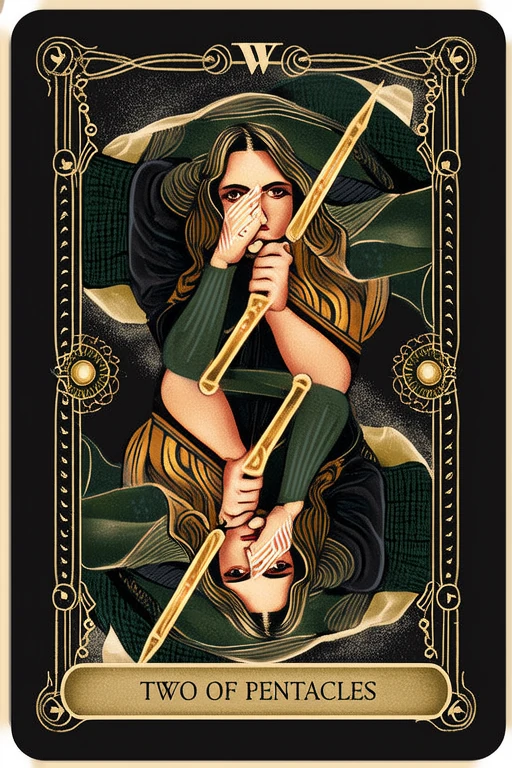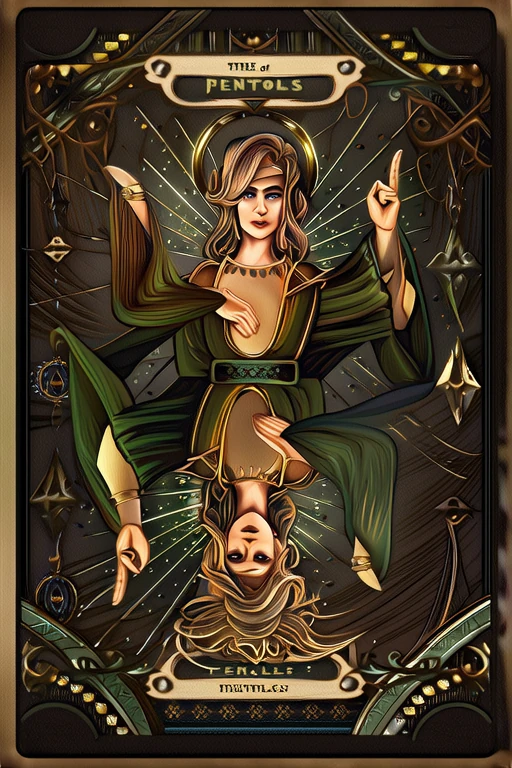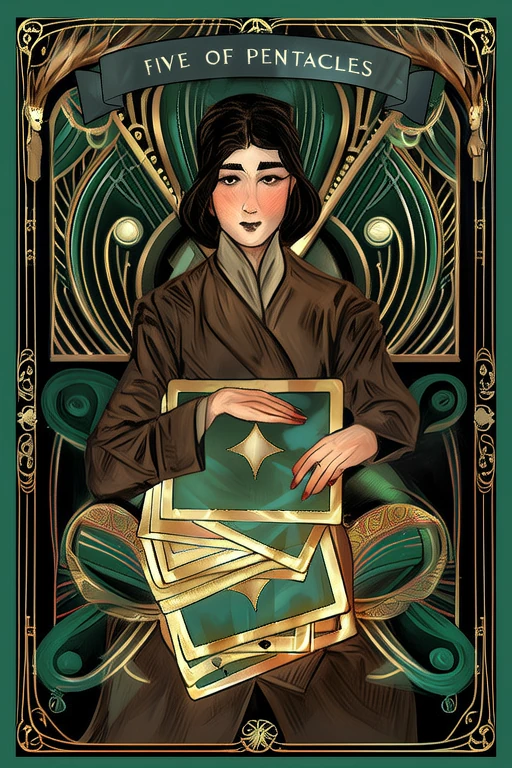
Ace of Pentacles
Discover the deep meaning of Ace of Pentacles with our free AI-powered tarot interpretation. Get instant, accurate readings based on advanced tarot knowledge.

Keywords
Upright Meaning
New financial opportunity, physical opportunity
Reversed Meaning
Lack of planning, perceived scarcity
Full Interpretation
The Ace of Pentacles represents new financial opportunities and material abundance.
In-Depth Analysis
📜 Historical Background
The Ace of Pentacles, also known as the Ace of Coins in some traditions, is one of the 56 Minor Arcana cards in a standard tarot deck. It belongs to the suit of Pentacles (or Coins), which corresponds to the element of Earth and is associated with material wealth, physical health, and the tangible aspects of life. The Minor Arcana is divided into four suits—Wands, Cups, Swords, and Pentacles—each containing numbered cards from Ace to Ten and four Court Cards (Page, Knight, Queen, King). The Ace of Pentacles marks the beginning of this suit, representing the purest form of Earth energy and material manifestation.
Historically, tarot cards originated in mid-15th century Europe, particularly in Italy and France, where they were used primarily for games rather than divination. The suit of Pentacles evolved from the suit of coins or disks in early tarot decks, such as the Visconti-Sforza and Marseille decks. In these decks, the Aces served as the source of power for each suit, embodying the raw potential of the suit’s element. The Ace of Pentacles, therefore, symbolized the seed of material abundance and earthly prosperity.
In the Visconti-Sforza deck, one of the oldest surviving tarot decks, the Ace of Pentacles is depicted as a simple golden coin or disc held in a hand emerging from the clouds. This imagery has persisted through the centuries, emphasizing divine providence and the spiritual origin of material blessings. The Marseille tradition, which became a foundational influence on later occult tarot, also depicted the card with a single coin, often adorned with floral or geometric patterns that symbolized nature and abundance.
The Rider-Waite-Smith deck, created by A.E. Waite and illustrated by Pamela Colman Smith in 1909, introduced a more symbolic and accessible visual language. In this deck, the Ace of Pentacles shows a hand holding a single golden coin, surrounded by lush greenery and a tree-laden landscape. This imagery emphasizes growth, fertility, and the promise of material success. The card’s evolution reflects a growing emphasis on personal manifestation and spiritual alignment with earthly resources.
Across cultures, the Ace of Pentacles has been interpreted through various lenses. In some esoteric traditions, it is linked to the Qabalistic Sephirah of Malkuth, the realm of physical manifestation and the material world. In modern Wiccan and pagan practices, it is often associated with prosperity spells and rituals. The card’s enduring symbolism speaks to humanity’s deep connection with material security, abundance, and the tangible rewards of effort and intention.
Symbolism & Imagery
The Ace of Pentacles is rich in symbolic meaning, with each element of its imagery contributing to a deeper understanding of its significance in a tarot reading. At the center of the card is a single golden coin or pentacle, held in a hand that emerges from the clouds. This image symbolizes the divine origin of material blessings and the idea that abundance often comes from unexpected or higher sources. The cloud represents the spiritual realm, suggesting that prosperity is not solely the result of human effort but can also be a gift from the universe or divine forces.
Surrounding the coin in many traditional depictions are elements of nature—such as trees, vines, and leaves—which symbolize growth, fertility, and the natural cycles of abundance. These natural elements emphasize the connection between material wealth and the earth, reinforcing the importance of grounding, stability, and environmental harmony. In the Rider-Waite-Smith tradition, the background landscape is lush and verdant, further reinforcing the themes of prosperity and opportunity.
Color plays a significant role in the symbolism of the Ace of Pentacles. The golden hue of the coin represents wealth, value, and the sun’s life-giving energy. Green, often used in the surrounding foliage, signifies growth, renewal, and balance. These colors combine to evoke a sense of grounded optimism and the potential for material success.
Numerologically, the number One is associated with beginnings, leadership, and independence. As the first card in the suit of Pentacles, the Ace represents the seed of material manifestation, the starting point of financial or physical ventures. It is a card of opportunity, encouraging the querent to seize the moment and take practical steps toward their goals.
Culturally, interpretations of the Ace of Pentacles may vary. In some traditions, it is viewed primarily as a card of financial gain, while in others, it is seen as a sign of good health or a new home. In Jungian psychology, the Ace of Pentacles can be associated with the archetype of the Provider or the Nurturer, representing the need to care for oneself and others through material means.
When upright, the Ace of Pentacles signifies new opportunities in the material realm—such as job offers, financial windfalls, or physical healing. It encourages the querent to accept these blessings with gratitude and to take practical steps to manifest their desires. In reverse, the card may indicate missed opportunities, financial instability, or a disconnection from the physical world. It can also suggest a need to reassess one’s values or to be more mindful of material resources.
In the context of the entire tarot deck, the Ace of Pentacles is closely connected to the other Aces, all of which represent the pure essence of their respective elements. It also resonates with the Ten of Pentacles, which shows the culmination of material success and legacy. Together, these cards form a narrative of material manifestation and earthly fulfillment.
Psychological Insights
From a psychological perspective, the Ace of Pentacles embodies the human desire for security, stability, and tangible success. In Carl Jung’s framework of archetypes, the card aligns with the archetype of the Provider or the Caregiver, representing the need to nurture oneself and others through material means. It reflects the fundamental human instinct to seek comfort, safety, and sustenance in the physical world. This card encourages individuals to ground themselves in reality and to take practical steps toward achieving their goals.
In modern life, the Ace of Pentacles serves as a reminder of the importance of financial literacy, physical health, and practical planning. It often appears when a new opportunity arises—whether in the form of a job offer, a business venture, or a financial windfall. Psychologically, it encourages individuals to trust in their ability to manifest abundance and to take action when presented with favorable circumstances. It also promotes a balanced approach to materialism, urging individuals to value security without becoming overly attached to possessions.
For personal growth and self-awareness, the Ace of Pentacles invites individuals to examine their relationship with money, resources, and the physical world. It challenges people to cultivate a sense of gratitude for what they have while remaining open to future abundance. Those who resonate with this card may benefit from developing practical skills, setting financial goals, and investing in their well-being.
In therapeutic and counseling settings, the Ace of Pentacles can be a powerful tool for discussing financial stress, health concerns, or life transitions. It encourages clients to take a grounded and realistic approach to their challenges, focusing on achievable solutions rather than abstract worries. Counselors may use this card to guide discussions about budgeting, career planning, or lifestyle changes that promote long-term stability.
In modern spiritual practices, the Ace of Pentacles is often used in abundance rituals, prosperity meditations, and manifestation work. It is associated with gratitude, manifestation, and the law of attraction. Many practitioners use the card in spellwork involving crystals, herbs, or affirmations designed to attract financial blessings and physical well-being. Ultimately, the Ace of Pentacles serves as a reminder that spiritual growth and material success are not mutually exclusive but can coexist harmoniously when approached with intention and mindfulness.
Correspondences
The Ace of Pentacles is deeply connected to the element of Earth, representing stability, material wealth, and physical well-being. Astrologically, it is associated with the planet Mercury in the sign of Virgo, which governs practicality, organization, and health. This planetary influence reinforces the card’s themes of grounded abundance, careful planning, and attention to detail. Additionally, it resonates with Taurus, an Earth sign ruled by Venus, which enhances its connection to financial security, comfort, and sensual pleasures.
Gemstones and crystals associated with the Ace of Pentacles include citrine, known as the merchant’s stone for attracting wealth; green aventurine, which promotes prosperity and opportunity; and pyrite, which supports financial success and protection. These stones can be used in meditation, carried as talismans, or placed in workspaces to enhance abundance and stability.
Herbs and plants that correspond to this card include basil for attracting money, cinnamon for prosperity spells, and bay leaves for protection and success. Essential oils such as patchouli, which is linked to wealth and grounding, and sandalwood, which promotes clarity and abundance, are often used in aromatherapy and ritual work associated with the Ace of Pentacles.
This card is most potent during the season of autumn, when the harvest is gathered, and in the late afternoon, a time associated with reflection and preparation. As an Earth card, it aligns with the North direction and is particularly powerful when used in rituals connected to grounding, manifestation, and financial planning.
Energetically, the Ace of Pentacles is linked to the Root Chakra (Muladhara), which governs survival, security, and physical well-being. Balancing this chakra can help individuals feel more grounded and connected to the material world, enhancing their ability to attract and maintain abundance.
Numerologically, the number One signifies beginnings, leadership, and self-reliance. In the context of the Ace of Pentacles, it represents the initiation of a new material venture, the start of a prosperous journey, and the potential for financial or physical success.
❓ Frequently Asked Questions
The Ace of Pentacles is one of the most sought-after cards in a tarot reading due to its strong association with material success and abundance. However, it also raises several questions, especially among beginners. One of the most common inquiries is: 'Does the Ace of Pentacles always mean money?' While it is strongly linked to financial gain, it can also represent physical health, a new home, or any tangible opportunity. It is important to interpret the card in the context of the entire reading and the querent’s specific situation.
Another frequent question is: 'What does the Ace of Pentacles reversed mean?' When reversed, this card may indicate missed opportunities, financial instability, or a need to reassess material priorities. It can also suggest a lack of grounding or an overattachment to material possessions. It serves as a reminder to examine one’s relationship with money and to approach resources with balance and intention.
Beginners often misinterpret the Ace of Pentacles as a guaranteed windfall or instant wealth. However, the card usually indicates the potential for prosperity rather than a guaranteed outcome. It encourages the querent to take practical steps toward their goals, such as applying for a job, investing wisely, or improving their health.
Professional readers use several techniques when interpreting the Ace of Pentacles. In a three-card spread, it often represents the present moment or an upcoming opportunity. In a Celtic Cross spread, it may appear in the fourth or fifth position, indicating a recent change or a material opportunity that has arisen. Readers may also look at surrounding cards to determine whether the Ace of Pentacles is being supported or blocked by other energies.
When the Ace of Pentacles appears with other cards, its meaning can shift. For example, when paired with the Two of Pentacles, it suggests balancing multiple financial or material concerns. When combined with the Six of Pentacles, it may indicate receiving or giving financial support. Conversely, if it appears near the Five of Pentacles, it may suggest that an opportunity exists but is currently obscured by hardship.
To interpret the Ace of Pentacles effectively, it is essential to consider both its upright and reversed meanings, its placement in the spread, and its relationship with other cards. Readers should also encourage the querent to reflect on their current material situation and consider how they can best utilize the energy of this card to manifest abundance in a grounded and sustainable way.



